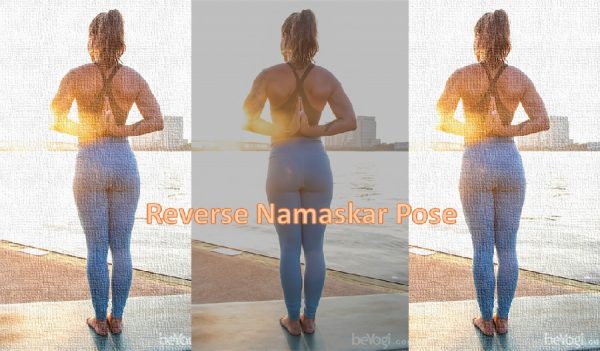
Reverse Namaskar Pose
Tadasana Paschima Namaskar or reverse namaskar pose is a beginner/intermediate pose that helps to strengthen abdomen, shoulder and arms. It is a chest opener pose and one should be careful while bending and taking hands back. This pose is good for those who suffer from back pain. It eases hand movements and gives flexibility -Healthylife
LEVEL :Intermediate
Anatomy
- Abdomen|Arms|Chest|Shoulders
Pose Type
- Arm Variation|Backbend
Sanskrit :
Tadasana Paschima Namaskar
paschima = backside of the body namaskar = to join the hands in prayer
tada = mountain tah-dahs-anna pah-she-mah nah-mah-skar-ahs-anna
Benefits
- Opens the chest and abdomen
- Lessens stress and quiets the mind
- Enhances flexibility in shoulders, arms, chest, and upper back
- Improves posture
Contradictions:
- Shoulder injury or pain
- Wrist injury or pain
- Low blood pressure
- Insomnia or headaches
How To
- From standing or seated, rest your arms loosely by your side
- Find minor core engagement
- Tuck your chin in slightly towards your chest
- Lengthen your spine
- Reach your arms behind you with palms facing each other
- Bend your elbows and reach your fingertips towards one another
- If accessible, keep your shoulders relaxed and broaden your chest as your palms meet behind your back
- Rest your palms together and your pinky fingers against your spinal column
- Modify or Replace
- Look toward the floor if any strain is felt in the neck.
- Practice the pose with the feet hip-distance apart.
- Widen the arms into a cactus position to lessen the stretch in the shoulders.
Sequencing Tips
Before:
- Mountain Pose (Tadasana)
- Easy Pose (Sukhasana)
After:
Teaching Cues
- Draw your shoulder blades, scapula, together
- Find core engagement and knit your low ribs inward
- Keep the hands pressed together from fingertips to the base of the palm
- Variations
- Bring your hands to grasp your wrists or forearms
- Find a standing posture, such as pyramid pose, and move into the full expression with your hands in namaskar
Watch Out For
- Shoulder strain
- Chest puffing out
- Loss of core engagement
- Neck strain
This article and image is published here with prior permission from beyogi.com
Author: HealthyLife | Posted on: October 24, 2019
« Twelve self-care tips help you to make your life better Why body builders need yoga »






















Write a comment